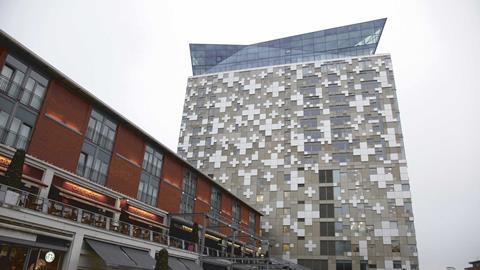Thorneycroft Solicitors secured its ABS licence two years after first approaching the SRA. Rachel Stow shares the highs and lows of the process
We didn’t necessarily set out to become an alternative business structure. It was only after we experienced a disappointing U-turn in relation to the Solicitors Regulation Authority’s policy on licensing multi-disciplinary practices that we elected to make the switch.
After attending a meeting at the Cube (pictured), we reached an agreement in principle on a proposed group structure to accommodate our six legal/insurance brands under a MDP licence, only for the regulator to change its mind when we came to submit the application.
The truth is that we were ahead of the game and the SRA’s nascent licensing procedures in respect of MDPs sent us back to the drawing board.
However, as a law firm we’ve always had a flexible approach to running our business which has been essential given the seismic changes to the personal injury market over recent years. We’d already engaged Weightmans’ Compli team to advise on possible structures to support our legal brands, and so once we knew the SRA was not yet ready to license MDPs we agreed that applying to become an ABS would give us the necessary structure to support our business plans. It also gave us the bonus of welcoming an experienced financial director to the board.
The whole process, from initial discussions with the SRA about the MDP licence to the ABS licence being granted, took about two years. These things do not move quickly, although I understand that the process has speeded up somewhat of late.
Readers will not be surprised to hear that there were frustrations along the way, but we also learnt a lot. I hope our approach and what we learned can help other firms preparing to go under the SRA’s ABS microscope:
How we prepared
- Start with the business plan. This is the most important document, even more so than the application forms because it explains your business and why you seek ABS conversion. Just because you are already a law firm does not mean that you do not need a business plan. If you cannot articulate your reasons for seeking an ABS licence then the SRA is unlikely to take your application seriously. Take this as an opportunity to outline your vision and set some goals for the first few years as an ABS.
- Consider the SRA Risk Outlook and any warning notices relevant to your work types. This will assist with completing the risk assessments contained in the application forms and anticipating what further questions may be posed by the SRA.
Lessons learnt
- Be prepared to explain commercial considerations. Sometimes the SRA doesn’t fully understand how any non-legal businesses in your group operate and how the market functions. ‘Regulation translation’ is sometimes needed to explain your business with reference to the SRA’s risk lexicon.
- Be prepared to compromise. The SRA will not necessarily agree to all of your proposals. Identify any higher-risk structures or potential points of contention before submission and decide on a fall-back position to save time with any SRA negotiations.
Frustrations with the SRA
- Delays. In the end we had to wait too long, which was frustrating when we had supplied everything the SRA needed to make a decision. We had to chase a lot and more often than not the ‘update’ wasn’t very informative.
- Rigid application of rules on material interests. Most of the criticism directed at the SRA in the ABS era has centred on material interests. Applicants have been unhappy at having to gather and submit disproportionate amounts of information in respect of those who hold a material interest but have no involvement in the day-to-day management of the ABS. Ironically, we requested approvals for individuals who we anticipated would hold a material interest in the ABS in the near future, but the SRA refused. This lack of pragmatism from the SRA was most disappointing, especially after all the regulator’s statements on flexible approaches to licensing.
I’d advise firms to go into this process with open eyes. It takes time and delays may occur so be sure to set a realistic timetable. Also set a realistic budget: while the cost of applying for an ABS licence is £2,000 plus £150 for every individual that requires approval, bear in mind the additional costs of preparation, any meetings with the SRA and ensuring that business continues as usual.
Also, it’s only natural to have an air of caution when dealing with your regulator, but a fully transparent approach is best and will prevent problems from arising further along. Nor should law firms be afraid of requesting a meeting with the SRA. Sometimes it can be the best way to explain your vision and discuss proposed structures. Even more important is to stand your ground. If you do not agree with the SRA’s interpretation on a particular point and are confident that you can meet the outcomes in the code, explain this to the regulator in a constructive and conciliatory manner.
Finally, do not forget your staff. While the day-to-day lives of the majority of our staff have changed very little as a result of becoming an ABS, it was important to communicate about what becoming an ABS would mean and what the process involves. We found that very few had any knowledge about ABSs and so it was good to be able to educate them at the outset and allay any fears or misunderstandings.
Rachel Stow is group CEO of TS Group Ltd, parent company of Thorneycroft Solicitors
































No comments yet